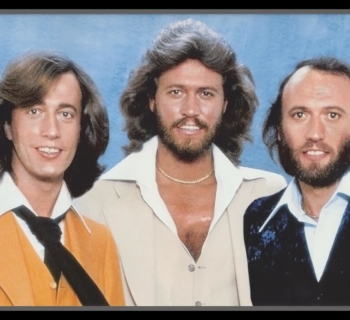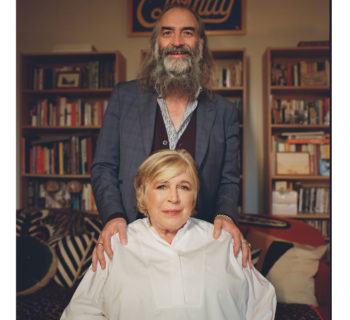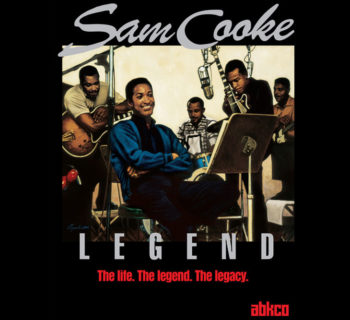PARACHUTE WOMEN: Marianne Faithfull, Marsha Hunt, Bianca Jagger, Anita Pallenberg, and the Women Behind the Rolling Stones By Elizabeth Winder.
By Harvey Kubernik Copyright 2023
PARACHUTE WOMEN: Marianne Faithfull, Marsha Hunt, Bianca Jagger, Anita Pallenberg, and the Women Behind the Rolling Stones by author Elizabeth Winder was recently published by Hachette Books.
Winder introduces us to the four unique women who inspired, styled, wrote for, and on occasion, remixed, and ultimately helped create the legend of the Rolling Stones. Marianne Faithful, Marsha Hunt, Bianca Jagger, and Anita Pallenberg.
Until this century, women in the rock 'n' roll books on the Rolling Stones were often cast or diminished as arm candy, consorts, groupies, and rarely given the credit and kudos for the muses who helped create the aesthetic that they brought to Mick Jagger and Keith Richards.
Parachute Women shows how viable and essential their role(s) were in establishing, informing, and enhancing the boys in the band in fashion, artistic flair and literary/studio contributions.
These women who helped shape the culture and legend around the band, before the lads became a brand, really gave at the office.
Elizabeth Winder is the author of Marilyn in Manhattan: Her Year of Joy and Pain, Parties, and Work: Sylvia Plath in New York, Summer 1953. Her work has appeared in the Chicago Review, Antioch Review, American Letters, and other publications. She is a graduate of the College of William and Mary, and earned an MFA in creative writing from George Mason University.
The Hachette Books media announcement touts the title:
"They opened the doors to subterranean art and alternative lifestyles, turned them on to Russian literature, occult practices, LSD, and high society. They connected them to cutting edge directors and writers, won them roles in art house films that renewed their appeal. They often acted as unpaid stylists, providing provocative looks from their personal wardrobes. They remixed tracks for chart-topping albums, and sometimes even wrote the actual songs. More hip to the times than the rockers themselves, they consciously (and unconsciously) kept the band current – and confident – with that mythic lasting power they still have today.
"Lush in detail and insight, and long overdue, Parachute Women is a group portrait of the four audacious women who transformed the Stones into international superstars but who were themselves marginalized by the male-dominated rock world of the late 60’s and early 70’s. Written in the tradition of Sheila Weller’s Girls Like Us, it’s a story of lust and rivalries, friendship and betrayals, hope and degradation, and the birth of rock and roll.
"In PARACHUTE WOMEN, readers will discover: How Marianne Faithful, Anita Pallenberg, and Marsha Hunt shaped a group of shy, slightly awkward boys into the rock icons that became known as the Rolling Stones, and how all three of the women – plus later, Bianca Jagger – provided vital emotional support and guidance in the band’s formative years.
"Personal accounts through the female lens of rock and roll – wild nights dancing on club tables, playing bumper cars with speed boats at Miami’s Fontainebleau hotel, cross-dressing on acid trips, and much more. The double standards for men and women surrounding sex and drugs in the rock and roll scene, and how those impacted the women’s own careers and public persona. Details of the band members’ intimate relationships with their lovers, other artists in the industry, and each other, plus the highs and lows in the lives of the Rolling Stones, from sold out stadiums and the height of glamour to unspeakable tragedy: overdoses, fires, and families torn apart."
Recent reviews praise Parachute Women:
“A wild ride worthy of rock’s heyday.”—Publisher’s Weekly
“Winder pairs extensive research with passages of conversational and creative nonfiction that make the book read like a novel.”—Library Journal
However, in Parachute Women, there are moments in Widner's narrative where existing quote sources aren't acknowledged or cited and where voices emerge in her study without any sort of introduction.
In July 2023, I met up with my dear friend, the photo journalist Heather Harris. A Westlake Girl...
We've been in a 50 year music book club together.
I emailed Heather after she read Parachute Women. I wanted her to set the scene on the photogenic women of the era that Widner chronicled.
"There were so very many of them! Here in the States the number of incontestably hip young women in the 1960s seemed attenuated for such a huge populace of a equally gigantic nation, but vestigial Puritan forces seemed to limit our own Swinging Sixties to a select few female musicians, groupies, actresses, models and activists. Otherwise, ratted bouffants and stiff, ultra-conservative wear were all one encountered.
"Across the pond offered far better hunting grounds for new, iconclastic young female souls carrying the banner of modernity in attitudes, fashion, creative output, nascent feminism and the seachange looks of wild straight hairstyles and clothes no one would ever mistake for that of any older generation.
"So even we American teens of the '60s thrilled to the 'one of ours' recognition of British and European new icons like Jean and Chrissie Shrimpton, Pattie and Jenny Boyd, Julie Christie, Jane Asher, Donyale Luna, Twiggy, Talitha Getty, Jane Birkin, Alice, Jane and Victoria Ormsby-Gore, all of David Bailey's favorite fashion models and the hundred plus young XX chromosome professionals and scenesters in 1967's iconic compendium by John d Green Birds of Britain (haha.)
"Out of these hordes emerged seemingly impossible superlative stand outs, and the leading rock stars of the day snapped them up. Back in the day you were never going to see a better looking young blonde than Marianne Faithfull, she was born with the je ne c'est quoi beauty genes. (And even later. During the punk era, she stood out like a beacon in a darkened club watching her then boyfriend play. All eyes were on her, you couldn't miss her even with no light to speak of in a crowded audience of 200. And she was wearing the metallic pink boots I had coveted on the King's Road but couldn't afford. She could.)
"Elsewhere, Anita Pallenberg surpassed her gorgeous European fashion model classification by seeming to be, to all who encountered her, one of the most reckless extroverts to ever stride the planet.
"It's not surprising these young women fascinated all comers, we teens, their colleagues, peers and contemporaries, and even today continue to do so.
"Author Elizabeth Winder singled out a few of the best known cohorts of the Rolling Stones in the '60s and early '70s and put together a study of Faithfull, Pallenberg, Bianca Macias Jagger and Marsha Hunt, so that the reader does not have to collect the assorted Exile on Main Street volumes of Robert Greenfield and Charley Weber in their library, nor Faithful's autobiography nor Pallenberg's biography She's A Rainbow, nor Hunt's two autobiographies (Hunt's life is far more interesting than most ever suspect.)
"So, what do you get versus what do you lack in Parachute Women? You get to immerse yourself in Winder's research of the era and these shining humans in their prime, which is valuable entertainment and escapism in and of itself. She is capable of amusing, frisky phrasing like describing the 60's attired, buxom Hunt as 'bursting out of her buckskins.'
"The downside? Those in the know will question why Catherine James and all sorts of assorted key players didn't make the author's list. Subjective coda: yes, I was interested enough to have already owned Birds of Britain and a goodly number of David Bailey's wonderful photo collections, so my curiosity about this brand new book was sated.
"For those interested in the singular subjects like Pallenberg, better money might be spent on purchasing photographer Dominque Tarlé 's superb candids of Keith Richards, Pallenberg, family and friends shot in the South of France at their villa while recording Exile on Main Street. The reader is no doubt sufficiently intelligent to read between the pixels of these copious, lush, unique photographs."
With the publication of Parachute Women, I'm parading two top-billed stars of the expedition: Marianne Faithfull and Anita Pallenberg, joint omnipresent guiding forces behind Mick Jagger and Keith Richards during 1964-1977.
Reflections and personal encounters with and about the quartet are culled from my own archival and 2023 interviews with Faithfull, Andrew Loog Oldham, Jack Nitzsche, Denny Bruce, Heather Harris, Keith Richards, Gene Shiveley, Michael Lindsay-Hogg, Bill Wyman and Bobby Rogers of the Miracles.
Last century, ABKCO Records issued a collection of Faithfull’s songs of the ‘60’s, Marianne Faithfull’s Greatest Hits, spotlighting “As Tears Go By,” “Summer Nights,” “Come Stay With Me,” “This Little Bird,” and “Sister Morphine,” which she co-wrote with Mick Jagger and Keith Richards.
In 1994, Marianne Faithfull published Faithfull: An Autobiography, co-written with author David Dalton. I interviewed Marianne during 1995 at the Chateau Marmont in West Hollywood.
Marianne writes that some of the Rolling Stones characters in their songs came to life partially owing to LSD.
"Of course they did," she emphasized. "I don’t think acid is relative or relevant anymore. I wouldn’t do it again. But I think that it was important then, and I think it taught us a lot.
"They were all very much in love with me at that time. Not only me, but I was one of the many women they were in love with. I always thought 'Ruby Tuesday' was about me. [Smiles].
"Keith and I are still very close. I’m under his wing and I know I will always be under his wing," underscored Marianne.
"Brian [Jones] wasn’t as bad as everybody thinks. Well Brian was a genius but he was a very irritating person. Keith really loved Brian. I use Brian. I have a whole lot of friends on the other side that I call up when I need them. I use Brian, Janis and now I’ve got Tony Secunda and Denny Cordell. I cut out some things about Brian Jones. David Dalton went on and on and made him much more of a worse person than he was. He could only do that really because he was dead. He couldn’t go on and on about Keith and Anita or even me because I did the classic Buddhist thing: I just did a drive all blames into one. I made that decision. That is something I learned from Allen Ginsberg."
In our 1995 dialogue, Marianne and I also discussed Anita Pallenberg.
"Like most of the time I don’t remember what people were wearing. And I remember one thing, I think is the White Ball and the black dress. So, it’s only on very clear demarcations like clothed, unclothed, black, white that I really know exactly.
"Like most of the time I don’t remember what people were wearing. I remember what Allen was wearing, because often, Allen would take his clothes off. So, I would know that and understand that. And that’s a very simple situation.
"Now Anita actually remembers things only through what we were wearing, ‘cause that’s what she’s interested in. I don’t mean that as a put down. But that’s how she remembers things. When I say, 'Do you remember such and such a day…?' The way back for Anita is ‘Oh yea... You were wearing a red velvet …and I was wearing…’ You’d dig her, man."
In 1994, Pallenberg graduated from Central Saint Martins in London with a fashion and textile degree.
During a 2013 interview with well-respected record producer and artist manager Denny Bruce, who represented Jack Nitzsche, he reflected on his 1966-1969 encounters with Marianne Faithfull, Anita Pallenberg, Brian Jones and Keith Richards.
“Being in Los Angeles in 1966, Keith and Brian wanted to know if anybody, like Lowell Fulson, was playing at any blues club in town? ‘Tramp’ by Lowell was number one this week on their turntables. Jack took the whole band to Watts to see Etta James at the California Club. I went to one of the Aftermath sessions at RCA.
"In fall of 1967 I heard the final mix of Neil Young's ‘Expecting to Fly’ recording on Buffalo Springfield Again one night at Jack’s house. Keith Richards and Anita Pallenberg were there. Jack said it was 'the perfect recording to smoke pot with.'
"Earlier that afternoon I drove Keith and Anita in my Volkswagon to Disneyland. My first Cali car. I clearly remember driving my VW bug with Keith and Anita. That was it - just the three of us. Anita got in and then Keith got in, but didn't move the seat to get in the back. So it was hard to drive and shift gears with Anita's crotch on the floor mounted gear shift.
"She beamed and said, ‘This is fabulous being in a Volkswagen in Los Angeles!’
"Somewhere in the 1967 or ’68 time period Mick, Keith and Jack worked with Marianne Faithfull on 'Sister Morphine.' We went to a French restaurant. Keith and Anita liked getting out of the hotels. Marianne and Anita liked to swim in Jack's pool. During their visit we went out to eat several times. A little French place that was near Fairfax High School comes into mind.
"'Sister Morphine' was written at Jack's house, during the days of hanging by the swimming pool.
"What people forget was it was hard just to get into Disneyland in those days if you had long hair. I was lucky with Keith and Anita as it was a slow day there, and he was not wearing anything unusual. But showing up as 5 people, looking like a band, would have caused trouble with security. Jack and I were hassled when we went there with Buffy St, Marie, who was performing an afternoon show."
In October of 1969, Bruce and Richards went out shopping for clothes and record albums. Denny schlepped Keith over to Ed Pearl’s Ash Grove music club on Melrose Avenue which housed a record section run by collector Chris Peake. Keith forked out some big bucks for a rare 1965 copy of The Cool Sounds of Albert Collins. Denny at the time managed Collins.
During 2000, I conducted an interview with Jack Nitzsche at his Beachwood Canyon home.
Nitzsche did the choral arrangement for the choir on “You Can’t Always Get What You Want” from the Let It Bleed album. He phoned Merry Clayton to sing on “Gimme Shelter.” Nitzsche was a major contributor to both the Aftermath and Between The Buttons albums.
In the Stones’ recorded catalog, Nitzsche’s keyboard, harpsichord and percussion work can be heard on such gems as “Play With Fire,” “Yesterday’s Papers,” and “Sister Morphine” on Sticky Fingers. He played tambourine and piano on “Satisfaction,” and was the pianist on “Let’s Spend The Night Together.”
"I got the Stones booked on The T.A.M.I. Show. I put the band together and did all the arrangements. I was the musical director," volunteered Jack in one of our 2000 tapings.
“It was Mick who came to me about doing the soundtrack to Performance.
“In fact, Keith and Mick wouldn’t even talk to each other during those days. The [director] Donald Cammell was close to the Stones. He knew who I was from the beginning, and they didn’t have time to score the film. Nor did they want to. So, I went to London for some reason, and saw the film during that time. They were doing Let It Bleed.
“When I was in London, the apartment they got me was right around the corner where Keith was living with Anita. There’s some pleasant moments but not many because of what they were doing to Brian.
"Anita on the screen. God damn! You saw the film. I want to see it again. I thought ‘Memo From Turner’ had a clever lyric. I felt Mick was going in another direction from the band.
“The movie blew my mind the first time I saw it. Jesus Christ. I saw Performance without music. It’s very tame without music. It doesn’t take you to that crazy place. This is the only movie I have ever done where nobody interfered. Nobody. Donald Cammell would drop by the studio once in a while. He let me do whatever I wanted.
“To this day, I’ll be in a restaurant, or walking down the street, or leaving a screening on a lot somewhere like Paramount, and someone will yell out Performance! [Director] Billy Friedkin saw me walking, and across the street yelled ‘Performance!-the greatest use of music in a motion picture ever!’ That was nice.”
In 2018 ABKCO issued The Rolling Stones Rock and Roll Circus on DVD, a landmark 1968 event directed by Michael Lindsay-Hogg just prior to directing the Beatles Let It Be.
One of the highlights is Marianne Faithfull singing “Something Better,” a Barry Mann and Gerry Goffin tune, arranged by Jack Nitzsche and produced by Mick Jagger. Charlie Watts introduces Faithfull on screen.
In a 2019 interview I asked Michael Lindsay-Hogg about Marianne’s sequence in the film and his sweeping directorial pan displayed on screen.
“It goes back to the song,” he explained. “It goes back to Marianne and the years when she and Mick were going out together. She was a beautiful girl with a lovely figure. And she was the only girl except for Yoko Ono.
“Marianne appeared and I thought ‘this has to be about her and the camera work,’ a one of a kind beauty. And the way Tony Richmond lit her with her hair on her face. She was a beautiful young woman. It was partly celebrating her. And, then there is that long musical break where the camera circles around and ‘what would we cut away too?’ And so I thought ‘let’s do the unusual thing of just holding on her when she is not singing. Just move the camera around.
“I also wanted contrast with her because there were a lot of men on the show. Everyone on the show, except for Yoko, were guys. At the time there weren’t a lot of women in the rock ‘n’ roll world yet. There was wonderful Dusty Springfield, but mainly guys.”
“As far as photographing the Rolling Stones in 1963 and '64, they seemed more like five individuals," stressed the acclaimed photographer and CBE Terry O'Neill in a 2010 interview we did. "And Andrew Loog Oldham, who managed them and produced their recordings, understood. When I worked on a newspaper, if I couldn’t get over to his office to photograph someone he’d bring them over to The Daily Sketch office and I’d photograph them there. Marianne Faithfull came over one afternoon. Can you imagine that happening today?”
(On October 16, 2023, ACC ART BOOKS LTD is publishing THE ROLLING STONES: ICONS. 312 pages. $75.00. Introduction is penned by author Harvey Kubernik. Spanning six heady decades, and countless tours and album covers, this thrilling portfolio features imagery from some of the most eminent names in photography, alongside the photographers’ own memories and reflections. Includes photographs by Terry O’Neill, Gered Mankowitz, Linda McCartney, Ed Caraeff, Ken Regan, Dominque Tarle and founding member, bassist and photographer, Bill Wyman. Each photographer has selected images for their chapter and written an introductory text about their time working with the band
Harvey Kubernik is the author of 20 books, including 2009’s Canyon Of Dreams: The Magic And The Music Of Laurel Canyon and 2014’s Turn Up The Radio! Rock, Pop and Roll In Los Angeles 1956-1972. Sterling/Barnes and Noble in 2018 published Harvey and Kenneth Kubernik’s The Story Of The Band: From Big Pink To The Last Waltz. In2021 they wrote Jimi Hendrix: Voodoo Child for Sterling/Barnes and Noble. Otherworld Cottage Industries in 2020 published Harvey’s Docs That Rock, Music That Matters.
Kubernik’s writings are in several book anthologies. Most notably, The Rolling Stone Book Of The Beats and Drinking With Bukowski. Harvey wrote the liner notes to the CD re-releases of Carole King’s Tapestry, The Essential Carole King, Allen Ginsberg’s Kaddish, Elvis Presley The ’68 Comeback Special, The Ramones’ End of the Century and Big Brother & the Holding Company Captured Live at The Monterey International Pop Festival.
During 2006 Harvey spoke at the special hearings initiated by The Library of Congress held in Hollywood, California, discussing archiving practices and audiotape preservation. In 2017 Harvey Kubernik appeared at the Rock and Roll Hall of Fame in Cleveland, Ohio, as part of their Distinguished Speakers Series.
During 2022, producer/director Ron Chapman interviewed Harvey and hired him as a consultant for his music documentary, REVIVAL69: The Concert That Rocked the World, which celebrates and chronicles a 1969 rock festival in Toronto, Canada that spotlighted the debut of John Lennon's Plastic Ono Band along with the Doors, Alice Cooper, Chuck Berry, Little Richard, Bob Diddley, Jerry Lee Lewis and Gene Vincent. Shout! Factory has picked up the title for North American distribution.
In 2023, Harvey, photographer Henry Diltz and authors Eddie Fiegel, Barney Hoskyns and Chris Campion were filmed by French director France Swimberge for her Mamas & Papas documentary. Broadcast scheduled on the European arts television channel, Arte. Kubernik is the consultant for the film.
Kubernik was an on-screen interview subject for director O’Casey in 2019 on his BBC4-TV digital arts channel Christine McVie, Fleetwood Mac’s Songbird. The cast includes Christine McVie, Stan Webb of Chicken Shack, Mick Fleetwood, Stevie Nicks, John McVie, Christine’s family members, Heart’s Nancy Wilson, Mike Campbell, and Neil Finn.
Harvey was lensed for the 2013 BBC-TV documentary on Bobby Womack Across 110th Street, directed by James Meycock. Bobby Womack, Ronnie Wood from the Rolling Stones, Regina Womack, Damon Albarn of Blur/the Gorillaz, and Antonio Vargas are spotlighted.
Kubernik was a featured talking head in director Matthew O’Casey’s 2012 Queen at 40 documentary broadcast on BBC Television and released as a Blu-Ray DVD, Queen: Days Of Our Lives in 2014 via Eagle Rock Entertainment.
In May 2014, filmmaker O’Casey filmed Kubernik in his BBC-TV documentary on singer Meat Loaf, titled Meat Loaf; In and Out of Hell, broadcast in the US market in 2016 on the Showtime Cable TV channel. It was subsequently issued as a DVD via Sony Legacy.
Harvey has done stage lectures and movie analysis at the University of Southern California School of Cinema-Television, about filmmaker and pioneer cinema verité director and Oscar-winner D. A. Pennebaker examining his Bob Dylan Dont Look Back (1965), and David Bowie Ziggy and the Spiders From Mars (1973), films for instructor Dr. David James.














